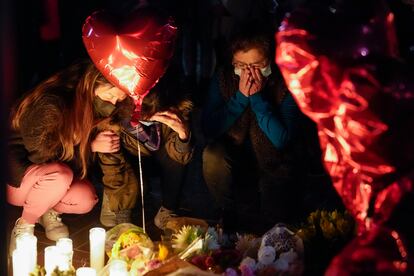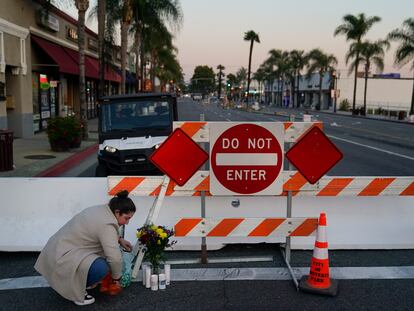New year brings a grim wave of mass killings across America
‘There are simply too many guns in this country. And there has to be a change,’ San Mateo County Board of Supervisors President Dave Pine said Monday

A year ago, the US marked its first deadly gun rampage of the year on Jan. 23. By the same date this year, there have been six mass killings that have claimed 39 lives, leaving communities nationwide reeling from the onslaught of violence.
Eleven people killed as they welcomed the Lunar New Year at a dance hall popular with older Asian Americans. Seven Chinese and Latino farmworkers killed amid the serene beauty of California’s Half Moon Bay. A teen mother and her baby shot dead in an attack that killed six people across five generations of her family.
“In the end, there are simply too many guns in this country. And there has to be a change. This is not an acceptable way for a modern society to live and conduct its affairs,” San Mateo County Board of Supervisors President Dave Pine said Monday, in the wake of the mushroom farm shootings about 30 miles (48 kilometers) south of San Francisco. “Our hearts are broken.”
The grim news from Half Moon Bay came as Californians were still trying to process the weekend carnage at the ballroom dance club in Monterey Park, a bustling Asian American community at the eastern edge of Los Angeles.
Americans in recent years have learned to endure mass shootings in churches and grocery stores, concerts and office parks, and inside the homes of friends and neighbors. The violence can stem from hatred toward other communities, grievances within a group, secrets within families and bitterness among colleagues. But it often ends when a man with a grudge grabs a gun.
Sometimes, it’s not even clear a grudge sparked the outburst.
“There was no apparent conflict between the parties. The male just walked in and started shooting,” Yakima Police Chief Matt Murray said after three people were shot dead at a Circle K convenience store in Washington state early Tuesday, adding to the nation’s grief.
A database of mass killings maintained by The Associated Press, USA Today and Northeastern University shows 2023 off to a particularly deadly start. The bloodshed began on Jan. 4, when a Utah man, investigated but never charged over a 2020 child abuse complaint, shot and killed his wife, her mother and their five children before killing himself.
The database shows 2,793 people have lost their lives in mass killings – those that involve four or more victims, excluding the killer – since 2006. And the recent wave of violence follows a spike in 2022, when the US recorded 42 mass killings, the second highest tally in that time span.
And even gunfire that takes fewer lives, or none at all, can shock the conscience, as was the case in Virginia this month when a six-year-old boy shot and wounded his teacher in front of his classmates. Virginia Beach Mayor Phillip Jones said he could barely wrap his head around it. And two teenage students were killed Monday in a school shooting in Iowa.
In the Saturday night shooting in Monterey Park, 11 people died and nine others were injured when a 72-year-old man opened fire at the Star Ballroom Dance Studio, just hours after tens of thousands of revelers filled the streets nearby for Lunar New Year festivities. The gunman killed himself as police approached his van the next day.
The 66-year-old suspect in the Half Moon Bay shooting was arrested in the parking lot of a police station. In both cases, investigators are still trying to learn what fueled the shootings.
“We have not even had time to grieve for those lost in the terrible shooting in Monterey Park. Gun violence must stop,” Pine said. “The status quo cannot be tolerated.”
Sign up for our weekly newsletter to get more English-language news coverage from EL PAÍS USA Edition
Tu suscripción se está usando en otro dispositivo
¿Quieres añadir otro usuario a tu suscripción?
Si continúas leyendo en este dispositivo, no se podrá leer en el otro.
FlechaTu suscripción se está usando en otro dispositivo y solo puedes acceder a EL PAÍS desde un dispositivo a la vez.
Si quieres compartir tu cuenta, cambia tu suscripción a la modalidad Premium, así podrás añadir otro usuario. Cada uno accederá con su propia cuenta de email, lo que os permitirá personalizar vuestra experiencia en EL PAÍS.
¿Tienes una suscripción de empresa? Accede aquí para contratar más cuentas.
En el caso de no saber quién está usando tu cuenta, te recomendamos cambiar tu contraseña aquí.
Si decides continuar compartiendo tu cuenta, este mensaje se mostrará en tu dispositivo y en el de la otra persona que está usando tu cuenta de forma indefinida, afectando a tu experiencia de lectura. Puedes consultar aquí los términos y condiciones de la suscripción digital.
More information
Archived In
Últimas noticias
Most viewed
- Reinhard Genzel, Nobel laureate in physics: ‘One-minute videos will never give you the truth’
- Oona Chaplin: ‘I told James Cameron that I was living in a treehouse and starting a permaculture project with a friend’
- Pablo Escobar’s hippos: A serious environmental problem, 40 years on
- Charles Dubouloz, mountaineering star, retires at 36 with a farewell tour inspired by Walter Bonatti
- Why we lost the habit of sleeping in two segments and how that changed our sense of time









































